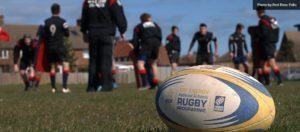Playing outside or inside center requires a very mixed bag of physical attributes – but then isn’t that true for all rugby positions?
Centers need to be strong, fast, agile, and able to kick, pass, sidestep, and tackle like a boss. Whether they’re attacking, defending, or supporting, centers are in the thick of it so they need to be fit too.
However, rugby skills aside, the best way for a center to improve their game is to develop greater speed and power. Speed and power are the foundation on which almost all other rugby physical attributes are built.
And, while training for these things, other components like strength, hypertrophy, and fitness will improve too.
What is speed and power?
Speed and power are easily confused, but are quite different attributes. Speed refers to quickness of movement and, in rugby at least, that normally means sprinting. Rugby can often devolve into a foot race – both when attacking or defending – where the faster sprinter scores the try or makes the vital tackle.
In contrast, power is strength produced quickly. Measured as Force × Distance ÷ Time, power is the combination of the amount of force generated and the velocity at which it is applied. For example, when doing a 1RM squat, the amount of force produced is very high, but the speed of movement is slow. However, in a squat jump, the force produced is just as high, but it’s produced for a much shorter time.
Speed and power are closely related but are dissimilar enough that they require different training methods. However, as speed increases, so too should power, and vice versa. A full explanation of this as it applies to the force-velocity curve can be found in our recommended leg workout.
Training for speed
Fitness adaptations from training are specific. That is to say, you get better at the things you train for. As sprinting is the main test of speed in rugby, it’s sprinting you need to do to become faster. It’s a case of practice makes perfect. Gym work and power training will undoubtedly help increase your speed potential, but if you want to sprint faster, you need to include sprinting in your workouts.
The best way to do this is to include specific sprint training in your weekly training schedule. The number of sessions per week will depend on whether you are in pre-season, off-season, or mid-season training and whether you are trying to improve or maintain your sprinting ability. You should be sprinting once or twice a week.
When training for speed, it’s important to understand that sprint training is VERY different to interval training. A lot of rugby players confuse the two. In interval training, the aim is to develop a high level of fitness by overloading the cardiovascular system. That means intense efforts, short rests, and lots of lactic acid. The ideal supplement to use during this kind of training is a nitric oxide booster.
While this IS an effective way to develop rugby-specific fitness, it’s a terrible way to develop speed. Why? Because as you get tired, your speed will decrease from one rep to the next and, because of the exercise law of specificity, that means you train yourself to sprint slower and not faster.
In contrast, true speed training is all about quality and not quantity. In fact, your sprint training sessions should be short and sharp, and terminated when you are no longer able to achieve maximum speed. For most players, this means sprint training sessions of 45 minutes or less, and that includes warm ups.
Unlike interval training, where rests between reps are kept purposely short, the rests between speed reps should be long enough for near maximal recovery i.e. 1-3 minutes. If you think of speed training as working close to your 1RM in the gym, this should make perfect sense.
As rugby centers can expect to sprint anywhere between 1 and 100 meters, they should include a variety of different distances in their sprint training workouts. Here is an example of a sample sprint training workout:
Warm Up – jogging, dynamic stretching, strides, and drills such as butt kickers, high knee running etc.
- 10 x 15m sprints (walk back slowly and recover as needed)
- 8 x 25m sprints (walk back slowly and recover as needed)
- 6 x 40m sprints (walk back and recover as needed)
- 4 x 70 m sprints (walk back and recover as needed)
- Cool Down – more light jogging, followed by static stretching and foam rolling
Need some sprinting inspiration? Check out this video of some of the fastest rugby players in history.
Training for power
Power, then, is strength expressed at speed. It’s the difference between a slow but heavy squat, and a fast, high vertical jump, or a 1RM bench press and a knockout punch. In rugby, it’s not enough to be Hulk-strong, you need to be able to produce that strength in an instant.
Power is usually developed in the gym, and traditionally involves Olympic lifting-type exercises and a type of training called plyometrics. In both forms of training, the aim is to generate maximal force as quickly as possible. This is not hypertrophy or strength training, where it’s okay to grind out the reps with no thought to velocity. In contrast, and like sprinting, if you are unable to generate maximal force and blistering speeds, you are merely training yourself to go slower. It’s that law of specificity in action again.
OLYMPIC LIFTING
There are two Olympic lifts; the clean and jerk, and the snatch. Both involve lifting a weight from the floor to overhead. In the clean and jerk this involves two distinct movements. The clean takes the bar from the floor to shoulder-height and the jerk takes the bar from the shoulders to overhead. In the snatch, the weight is taken from the floor to overhead in one movement. To do either of these lifts, you need to impart velocity to the bar and that means explosive, powerful movements. You cannot to the Olympic lifts slowly!
While the Olympic lifts are an effective way to develop power, they can be hard to learn, and you need high levels of coordination and flexibility to perform them properly. For some rugby players, this may delay the development of power because of the time needed to learn proper technique.
Thankfully, there are some simplified versions of the Olympic lifts that are just as effective for developing power, but are much easier to learn. These are often called the power variations and include the power clean and the power snatch. Normally using a reduced range of motion, these exercises fit easily into most gym-based training sessions.
Do them before strength exercises to fire up your nervous system before heavy lifting, or after squats and deadlifts to make the post of post-activation potential. Alternatively, do them on a separate day. Remember, however, to keep your reps low, your rests long, and focus on workout quality rather than quantity.
To see how to do the power variations of the Olympic lifts, check out these videos:
1. Power cleans
2. Power snatch
PLYOMETRICS
This type of training involves something called the stretch shortening reflex. This basically describes how a muscle can generate more force after being rapidly stretched. Plyometrics often involve jumping-type exercises, but any exercise that involves a rapid stretch phase before a powerful unload can be classed as plyometric.
Plyometrics overload your muscles without the need for lots of weight. In some ways, this makes them more practical than the Olympic lifts. Don’t let this lack of additional loading fool you though; plyos are still effective and demanding. In fact, some coaches go so far as to suggest that you should not do plyos until you can squat double your bodyweight.
Plyometrics usually involve a lot of impact force and for big, hefty rugby players, that can be a problem. Some exercises, such as depth jumps (also known as shock jumps) involve more impact that others, e.g. box jumps, so choose your exercises wisely and try to avoid doing too many high impact exercises in the same workout.
There are lots of different plyometric exercises to choose from, so it’s just a matter of choosing a couple per workout. Treat plyos like sprint and Olympic lifting training; focus on quality and not quantity, stopping your set the second you feel you are unable to generate maximal force. Long rests are compulsory, and all plyo exercises should be preceded with an appropriate warm up.
Good plyo exercises include:
- Squat jumps – bodyweight only, holding dumbbells, or with a barbell
- Depth jumps – jumps starting from a raised platform
- Split squat jumps
- Box jumps
- Hurdle jumps
- Bounding and hopping for distance
- Medicine ball throws
- Clap push-ups
You can learn more about plyometrics in this video:
And here are 23 different plyometric exercises to try:
Don’t be “that guy” who, when doing plyometrics, does so many reps that you barely even leave the floor during jumps. This is NOT a cardio conditioning workout. Each rep should be maximal effort. Low reps and long rests are the way ahead with plyo training – it’s basically in the same workout bracket as maximal strength training.
Training for speed and power will make you a better rugby player. But, of course, you need to support that training with adequate recovery and good nutrition. Get the most out of your workouts by using a good pre-workout before and recovery-boosting supplements afterward.


